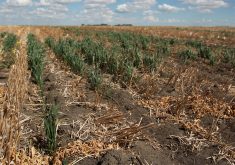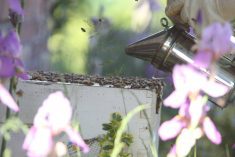Cow herd likely to shrink further following several years of dry conditions, particularly in province’s southwestern region
SWIFT CURRENT, Sask. — Drought will take its toll on the Saskatchewan cow herd again this fall, said Saskatchewan Cattlemen’s Association vice-chair Keith Day.
Speaking after the fall district meeting in his region and before some much-needed moisture a few days later, Day said the situation is worse than the 1980s after several years of drought in some parts of the province.
Producers have told him it’s the worst they’ve ever seen and they’re out of options.
“They have no grass, they have no water, they have no feed. They have basically one option left and that’s to get rid of cows,” he said. “And even the guys that have some feed and some water, and can make their grass stretch another season, are going to have to cut back quite a few cattle. I think there’s hardly anyone in this community or this area that isn’t going to be cutting back some.”
Read Also

House ag committee to undertake several studies
The House of Commons standing agriculture committee has set its agenda for the coming months. Members began the fall sitting with a two-hour update on international trade
Day said he wouldn’t be surprised to see some producers cut their breeding herd in half.
Rain at this point would help future runoff, he said. An inch or two of rain, followed by a freeze and snow would all be welcome.
“Right now, it could snow four feet deep and we wouldn’t get any runoff because the ground is dry and it wouldn’t run,” he said.
Producers at the meeting said the shrinking cow herd will lead to other issues, such as the continued loss of marginal land or grassland to grain production.
They discussed the need for improvements to forage-based crop insurance and continuation of federal-provincial programs to develop water sources.
Day, who raises cattle near Lacadena, said he wasn’t sure if the SCA would call for another payment similar to last year, in which producers were eligible for $200 per head in drought relief. He said that program didn’t work for everybody.
“But where it rained and where they had moisture in the spring it worked excellent. It did exactly what it was meant to do,” he said. “And if we’d have had the same moisture conditions here it would have worked the same for us.”
He said the drought has created conditions that affect animal health because it is so dusty and it’s a struggle for producers who are constantly treating calves.
“The price is better. It’s better than bad because last year was bad and this year is better for sure but we’re not quite there yet. It takes a lot of money when you’re buying feed, pumping water, hauling cattle. It takes a lot of money to keep operating.”
Producers passed a single resolution at this meeting, calling on the SCA to fund changes needed to the livestock manifest so that it can serve as a transfer of care document under federal transport regulations.
Resolutions passed at the recent district meetings are taken to the annual general meeting, scheduled for Jan. 26 during the Saskatchewan Beef Industry Conference in Saskatoon.


















